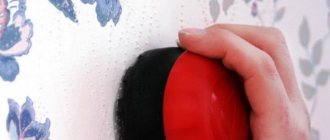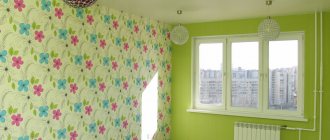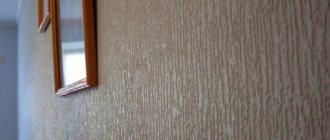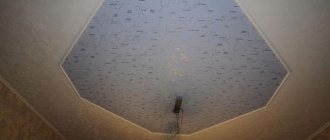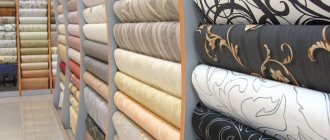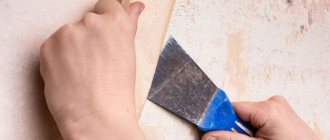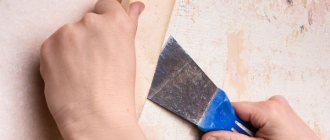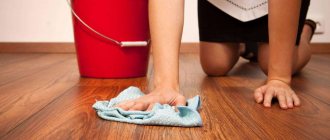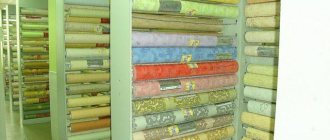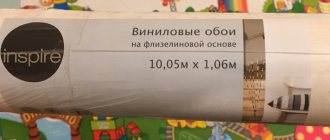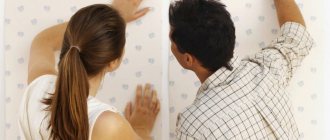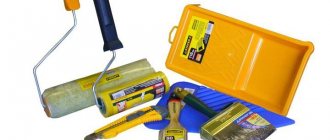Wallpaper is a wonderful finishing material that allows you to quickly change the appearance of your apartment beyond recognition. But many of those who are faced with the need to remove old trim find this process a real problem. What to do if you really want to update your interior, but the wallpaper just doesn’t want to separate from the ceiling or walls? Let's look at all the ways to remove outdated finishes, and also find out how to tear off old wallpaper if it is “tightly glued” to the wall.
If the wallpaper was recently glued, then there should be no problems with removing it at home, since modern starch-based adhesives are designed for subsequent easy removal of the finishing material.
Tools and materials
The choice of tool depends on the type of old finish that needs to be removed. Here is the most complete set of tools and devices that will help you quickly peel off obsolete wallpaper that has lost its former attractiveness:
- knives, spatulas, scrapers;
- “wallpaper tiger” or roller with nails;
- steam generator;
- wide roller with extension handle (for ceiling);
- hard brush;
- spray;
- special liquid for removing wallpaper;
- drill or grinder with a brush attachment;
- old blankets, film or packaging cardboard to protect furniture and floors;
- gloves and headgear;
- scotch;
- old rags or sponge;
- container with warm water.
You are unlikely to need a full arsenal, but it won’t hurt to stock up on most auxiliary equipment.
Before removing old wallpaper, do not forget to remove everything unnecessary from the room, remove curtains, take out carpets, and seal sockets and switches with tape to prevent moisture from entering them.
Peculiarities
The actual process of removing wallpaper should be preceded by a preparation process.
This stage involves the implementation of a number of events and actions: The room is completely cleared of furniture and interior items. All non-liftable objects, as well as unprotected surfaces, should be covered with polyethylene. The floor should be additionally covered with cardboard or heavy paper. This will avoid possible slipping on the floor surface. When entering the room where work is being done, you should lay down a wet cloth, which will prevent the spread of dirt and dust to other rooms. In the room where the wall covering is being dismantled, it is recommended to turn off the power to the wiring. This is necessary in order to avoid a short circuit. Sockets and switches, including, should be protected from moisture. They are hidden with tape or sealed with polyethylene.
Since moisture is often used in the process of removing old coating, some renovators are concerned that excess moisture could damage a plastered, puttied or primed wall. If high-quality materials were used to prepare the wall, and the work was carried out in good faith, then moisture and solvents will not cause damage. The only exception is when the walls are made of plasterboard, which is a very specific material.
Methods for removing wallpaper
There are several standard methods for removing wallpaper material.
When a wall is being prepared for pasting not ordinary paper wallpaper, but vinyl, non-woven, or washable wallpaper will be used, it must be cleaned of the old coating especially carefully.
Method number 1: use water
The process of removing old finishes from walls or ceilings without extra effort is not complete without a faithful assistant - warm water, and consists of wetting the walls to soften the layer of glue. The work can be done with a sponge, rag, roller or spray.
USEFUL INFORMATION: How to glue wallpaper under a suspended ceiling (video)
Tip: Add detergent to the water - this will increase the effectiveness of soaking.
Most often, after the glue has soaked, the thick paper material is very easily and quickly removed from the walls. It is better to do the work starting from the corners or from the bottom up. To do this, use the edge of a spatula or other working tool to pick up a corner of the wallpaper sheet and pull it towards you, simultaneously lifting it up.
Instead of water, you can use wallpaper remover, the principle of which is to destroy the adhesive structure. It is sold in hardware stores in concentrated form and diluted in the proportions indicated on the label.
Method No. 2: water + mechanical impact
How to remove wallpaper from walls if it does not absorb moisture well or is not capable of doing so at all, for example, washable, non-woven, vinyl? In this situation, it is necessary to make cuts or holes throughout the entire covered area. This can be done with a sharp corner of a spatula, a knife, a roller with nails protruding from it, or a “wallpaper tiger” - a specially created device for applying scratches to wallpaper.
After the vinyl or other durable wallpaper is cut or perforated, you will again need warm water, which you need to wet the covered wall with and wait 15–20 minutes. Then the same steps are performed as in method No. 1, aimed directly at removing the coating from the wall.
Method number 3: hot steam
You can make glue and paper swell using a steam generator, a steam mop, or even an iron with a steam function. After exposure to steam, most coatings can be removed from walls and ceilings quickly and easily with a wide spatula or scraper.
Option one
Vinyl coatings withstand water very well, which is why such coatings are even used in the bathroom. In a normal situation this would be a positive quality, but in this case we need to remove them, so it is necessary to break the top protective layer. A roller with a needle surface is perfect for this.
Roll it over the entire surface that will be removed. Once there are enough holes in the canvas, you can wet the wallpaper without difficulty. In this case, the wall itself will not receive any damage, unless, of course, you are too zealous with the roller. After this treatment, the strips are easily separated from the base and removed without any difficulty.
How to remove vinyl wallpaper
How to easily remove old PVC wallpaper? Vinyl wallpaper is made by fusing a thin film of vinyl with a paper or non-woven base. To remove them, you need to follow the steps from method No. 2, only instead of standard methods of separating material from the wall, it is better to do the following:
- make a horizontal cut at the top of the wall;
- gently pull the sheet by the edge - the durable structure of the vinyl allows you to remove entire sheets, which greatly facilitates and speeds up the work;
- the remaining fragments of the bottom layer of paper are removed with water in the usual way (No. 1).
When removal is difficult, it is better to use a steam generator.
With vinyl wallpaper on a durable non-woven base, you can separate only the top layer and leave the bottom layer on the wall, gluing new sheets directly onto it.
When is withdrawal necessary (and when not)
Inexperienced or unscrupulous finishers may claim that it is acceptable to glue the finish over the old one. Supposedly it will fit even better and last longer. This statement did not come out of nowhere. Indeed, strips of paper need a backing and lie better on previously glued materials. Once upon a time, there were no other wallpapers except paper. Then, before gluing, they even pasted a layer of old newspapers as a backing.
Modern decor is very different. These are one-, two- and multi-layer materials on various bases: non-woven fabric, paper, fiberglass. The coverage also varies. There are many models of moisture-resistant and washable fabrics with a water-repellent top layer. Such materials cannot become the basis for further finishing. The waterproof coating will not absorb the glue, and the new finish will not stick to such a base.
In addition, the materials have different densities. Therefore, those impregnated with an adhesive composition will dry differently. As a result, creases, bubbles and folds will inevitably appear on the new decor.
You can leave the old design when it is made of paper, and the new decor is the same. But even then you need to make sure that the adhesion to the base is good and will withstand the weight of another panel. If not, dismantling is indicated.
There is another case when the stripes are not removed. Or rather, they are partially removed. It refers to multilayer coatings. When dismantling such, the upper layers are removed, the lower one is held tighter. If it is non-woven fabric, there is no need to remove it. It will strengthen the base and become a good base for decoration. In this case, the paper must be removed.
Instagram kleim_krasim.ru
Instagram nastya.prigoda
- Decoration Materials
Applied instructions: how to remove paint from walls
Radical method of removal
If you need to tear off material from the walls or ceiling that is glued very tightly, for example, preserved from Soviet times, you may encounter serious difficulties. Previously, during repairs, carpenter's glue, bustilate, and PVA were used, which are capable of gluing wallpaper to the wall for centuries and are completely resistant to ordinary soaking.
A drill with a brush attachment will help, with which the coating can simply be mechanically removed from the wall. This method has a drawback: a stiff brush will remove not only wallpaper from the walls, but also a layer of putty, and possibly pieces of plaster.
Preparatory stage
Before you begin removing vinyl wall coverings, you need to prepare the room. It is best to clear the room of furniture. During the work, it can get dirty and simply get in the way. Interior elements that cannot be removed are covered with film or sheets. It is also better to cover the floors with film. Place sheets of cardboard or fairly thick paper on top of it. A damp cloth is laid on the threshold. It will collect dust and debris.
To avoid electrical accidents, experts recommend turning off the power to the wiring. To reduce the risk of moisture getting into sockets, it is recommended to cover them with film.
3
Vinyl - remove from the wall in three ways
Compared to conventional paper decorative covering, vinyl wallpaper is not so easy to remove. In order for the process to be effective, three methods can be used. The first consists of stages:
1. Perforation. In order to separate the paper from the wall, just wet it. It won't be that easy with vinyl, because... it does not allow water to pass through. It is necessary to make sure that holes are formed in the outer layer through which moisture gets onto the paper backing. To do this, treat the top layer with a special spiked roller. This will help not damage the wall and allow water to enter the material.2. Hydration. Treat the surface with a damp cloth or roller. To do this, you can use either ordinary warm water or a special removing liquid.3. After the material is well saturated with moisture, remove it, starting from the bottom up. Remove the remaining pieces with a spatula; it is better if it is wooden - this way you will avoid the appearance of damaged areas.
We recommend: Applying liquid wallpaper to the ceiling
To moisten the wallpaper, you can use a damp cloth and regular warm water.
The older the coating, the longer it will take to saturate it. Very old vinyl wallpaper should be kept damp for about an hour - after that it will not be difficult to remove it from the walls. Usually the material comes off in whole stripes, without breaks.
The second method is suitable for cases where strong glue was used or the coating is very ancient. Instead of a spatula, take any of the following tools:
a drill and a special attachment in the form of a round brush; coarse sandpaper and a grinder; a regular metal brush for washing dishes.
The first two options will help you get rid of old coating quickly and with a minimum of effort. The third one will have to work hard. All three methods are suitable when there is no plaster on the wall under the wallpaper layer. If available, use the latter method. First, treat the wall with a needle roller, wet the surface with water mixed with fabric softener, vinegar and ammonia in approximately equal proportions. Wait 20 minutes - the old glue dissolves, the wallpaper sheets can be easily peeled off without damaging the wall base.
How to Remove Wallpaper from Drywall
If the walls or ceiling covered with plasterboard were not treated with a special primer before gluing, any wallpaper, non-woven, washable, vinyl and paper, will stick to it incredibly firmly. In addition, the top layer of drywall can be easily damaged, and it is also not friendly with water. To remove the coating from this material you can use:
USEFUL INFORMATION: Puttying wall corners
- Means for dissolving glue. Apply in very moderate quantities - the drywall should not get wet along with the wallpaper.
- Wallpaper glue. It is spread on the surface, causing the wallpaper to swell and bubble.
- Primer. Perfectly impregnates wallpaper material, evaporates slowly, and does not harm gypsum boards.
Important! When removing wallpaper, handle the spatula carefully so as not to damage the integrity of the top layer of drywall.
Third option
You can use a special mixture instead of water. This is wallpaper glue diluted with water and wallpaper remover. A little glue is added, and water and wallpaper remover are added almost equally. There is a little less water. Perforation is done as in previous cases.
This mixture is applied to a perforated canvas and left for three hours. After this, the canvases will move away from the base in whole pieces. Do not overdo the mixture as this may wet the base too much.
Non-standard cases
1. Vinyl wallpaper is not always glued using a special glue. It happens that completely unsuitable products are used for this (for example, PVA) that are resistant to dissolution by water. If it turns out that this is the case in your case, it will be quite difficult without a grinding machine or drill with a special attachment (round metal brush). With an ordinary sharp spatula, cleaning a wall from wallpaper glued with inappropriate glue will take a lot of effort and time.
2. If the wallpaper was glued to a plasterboard wall, excessive waterlogging can damage this material. Therefore, try to limit the amount of liquid you use. It is better to use a wallpaper remover, then carefully remove it with a spatula. If PVA (or other glue not intended for this purpose) was used during gluing, alas, you will have to completely change the drywall.
